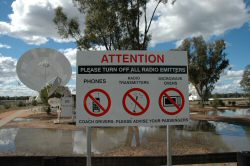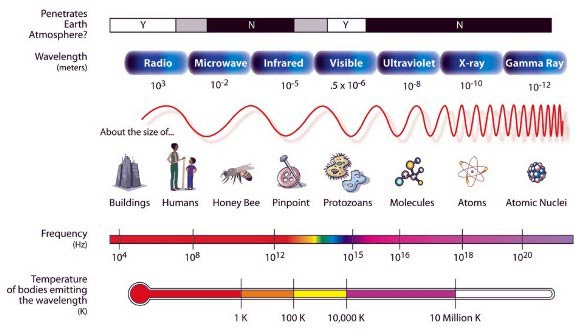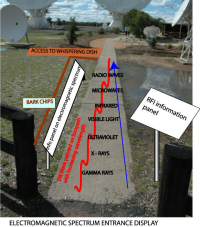Narrabri visitor centre redevelopment
Concept for Electromagnetic Spectrum Walk
v1 - 1 September2004
Link to majordomo discussion
This version describes a possible concept and exhibit for the redevelopment of the Australia Telescope Narrabri visitors centre.
Setting the Scene - Arrival
As visitors arrive in the car park they are currently presented with a formidable-looking RFI warning sign asking them to turn off their mobile phones and other devices that cause interference. Whilst hopefully effective and noticeable it would be worthwhile to place it in context and use this as an introduction to the concept of the electromagnetic spectrum. The image below shows the warning sign.

The proposal detailed here carries this theme across to the visitors' entry into the new outdoors display area. On entering the gateway to the footpath leading up to the VC visitors will be presented with two sets of information.
- The left-hand side of the footpath will have a raised display panel running most of the length of the path. This will contain schematic diagrams and information on the electromagnetic spectrum. The footpath itself could also have art work showing a labelled wave increasing in wavelength as we start with gamma rays at the gate and finish with radio waves up near the next junction.
- On the right-hand side will be an information panel explaining what RFI is, its causes, impact and prevention. This panel could be either near the entrance gate or further up the path near the end of the electromagnetic spectrum "walk"
The small picture below shows the scene visitors have on entering the gateway. A larger version is available here.
Rationale for the Display
The electromagnetic spectrum is the key source of information about the Universe available to astronomers. Astronomers are now able to observe across all wavebands of the spectrum.
- An understanding of the em spectrum provides the basic conceptual idea need for visitors to interpret the role, function and discoveries of the Compact Array.
- Once the basics of the em spectrum are introduced early into a visit, later displays can build on the concepts introduced (comparison of optical and radio images of same astronomical object for example).
- The entrance path lends itself to a linear display such as this. The proposed display will be both visually engaging and informative without being too "dense" in depth.
- The path leads people towards the telescope. By pacing the em spectrum section at the start of the tour they should arrive at the telescope interpretives and displays.
- The electromagnetic spectrum is a key part of science syllabi across Australia so having an engaging display increases the relevance for visiting schools.
The Display
The main em spectrum display could comprise two key components; the raised information panel next to the left-hand side of the path and the path itself. The RFI information panel would be on the right-hand side of the path, either at the start or up ne ar the junction.
The displays will be mostly illustrations and images with minimal amounts of text. The graphics and style of the spectrum panel will match the style of those used elsewhere at the VC.
The concept for the display can be traced back to this useful NASA image.

Display Panel
The panel would run along the left-hand side of the footpath. This is currently grassed but would work more effectively if a strip of this was instead covered with bark chips as with many of the other walkways. The em spectrum panel could contain the f ollowing information:
- Regions of the em spectrum. These will be listed in order of increasing wavelength so that we end up with radio waves up closer to the telescope.
- Size of wavelength both in metres and in comparison with a similar-sized object such as an atom or insect as per above.
- Frequency could also be included (with perhaps mention that higher frequency means shorter wavelength). Could also relate this to energy in the waves.
- How the waveband can be detected in non-astronomical examples such as X-Rays on film, UV as sunburn and radio waves in television.
- Non-astronomical applications of each waveband. In each waveband the idea would be to show how its use is strongly linked in our daily lives. Some examples could be use of gamma rays for sterilising wound dressing, infrared in television remote cont rols and heat sensors, UV in signature detection and possible how birds see flower petals.
- An astronomical object at that waveband (this would not ideally be explained in detail but could serve as a "teaser" for later displays further around the circuit.
- The display would also have a representation of a wave running along its length. This would increase in wavelength as it goes through the different wavebands. It would serve to illustrate that the boundaries between specific wavebands are in fact so mewhat arbitrary and that the em spectrum is continuous rather than totally separate divisions.
- Other possible inclusions are whether astronomers can detect it from Earth or instead need to go into space, the temperature of the source and possible physical causes or mechanisms by which the waveband is produced. This may be too wordy and detail ed for the display though as the emphasis is on an uncluttered presentation.
The panel would end before the junction so as to allow visitors access to the whispering dish near the Visitors Centre. A formal path could be added here to aid access to the dish.
Footpath
The path itself could contain one or more of the above elements. The continuous wave may be easiest although wavebands could also be shown in prominent letters. We may also be able to include some images of astronomical objects. Concerns with this are :
- Safety of visitors; if they are looking down too much they may trip over or bump into things or each other.
- Painted surfaces may prove slippery - have to take care in selecting appropriate paint.
- Durability of whatever is painted on surface.
- Possible distraction from side display panel.
The footpath em spectrum walk ends up near the junction of the loop around the Visitors Centre. Visitors will be naturally drawn further along by displays that lead towards the telescope. They may also branch right to the display areas at the back of t he VC or left towards the whispering dish.
Original: Robert Hollow (1-September-2004)

